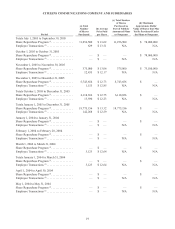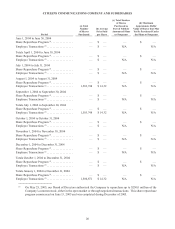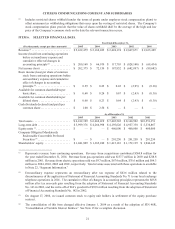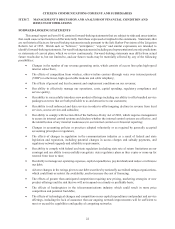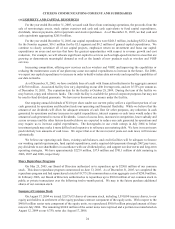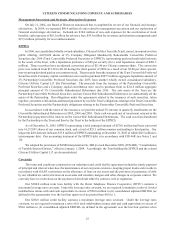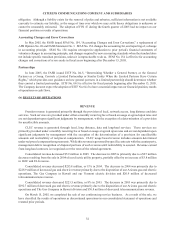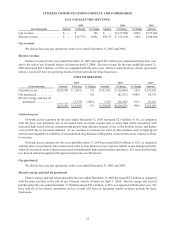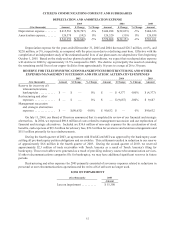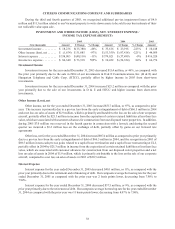Frontier Communications 2005 Annual Report Download - page 31
Download and view the complete annual report
Please find page 31 of the 2005 Frontier Communications annual report below. You can navigate through the pages in the report by either clicking on the pages listed below, or by using the keyword search tool below to find specific information within the annual report.29
CITIZENS COMMUNICATIONS COMPANY AND SUBSIDIARIES
Depreciation and Amortization
The calculation of depreciation and amortization expense is based on the estimated economic useful lives of the
underlying property, plant and equipment and identifiable intangible assets. An independent study of the estimated
useful lives of our plant assets was completed in 2005. We adopted the lives proposed in that study effective October
1, 2005.
Intangibles
Our indefinite lived intangibles consist of goodwill and trade name, which resulted from the purchase of ILEC
properties. We test for impairment of these assets annually, or more frequently, as circumstances warrant. All of our
ILEC properties share similar economic characteristics and as a result, our reporting unit is the ILEC segment. In
determining fair value of goodwill during 2005 we compared the net book value of the ILEC assets to trading values
of our publicly traded common stock. Additionally, we utilized a range of prices to gauge sensitivity. Our test
determined that fair value exceeded book value of goodwill. An independent third party appraiser analyzed trade
name.
Pension and Other Postretirement Benefits
Our estimates of pension expense, other post retirement benefits including retiree medical benefits and related
liabilities are “critical accounting estimates.” We sponsor a noncontributory defined benefit pension plan covering
a significant number of our employees and other post retirement benefit plans that provide medical, dental, life
insurance benefits and other benefits for covered retired employees and their beneficiaries and covered dependents.
The accounting results for pension and post retirement benefit costs and obligations are dependent upon various
actuarial assumptions applied in the determination of such amounts. These actuarial assumptions include the
following: discount rates, expected long-term rate of return on plan assets, future compensation increases, employee
turnover, healthcare cost trend rates, expected retirement age, optional form of benefit and mortality. We review
these assumptions for changes annually with its outside actuaries. We consider our discount rate and expected long-
term rate of return on plan assets to be our most critical assumptions.
The discount rate is used to value, on a present basis, our pension and post retirement benefit obligation as of
the balance sheet date. The same rate is also used in the interest cost component of the pension and post retirement
benefit cost determination for the following year. The measurement date used in the selection of our discount rate is
the balance sheet date. Our discount rate assumption is determined annually with assistance from our actuaries
based on the duration of our pension and postretirement benefit liabilities, the pattern of expected future benefit
payments and the prevailing rates available on long-term, high quality corporate bonds that approximate the benefit
obligation. In making this determination we consider, among other things, the yields on the Citigroup Pension
Discount Curve and Bloomberg Finance. This rate can change from year-to-year based on market conditions that
impact corporate bond yields. Our discount rate declined from 6.00% at year-end 2004 to 5.625% at year-end
2005.
The expected long-term rate of return on plan assets is applied in the determination of periodic pension and
post retirement benefit cost as a reduction in the computation of the expense. In developing the expected long-term
rate of return assumption, we considered published surveys of expected market returns, 10 and 20 year actual returns
of various major indices, and our own historical 5-year and 10-year investment returns. The expected long-term rate
of return on plan assets is based on an asset allocation assumption of 30% to 45% in fixed income securities, 45% to
55% in equity securities and 5% to 15% in alternative investments. We review our asset allocation at least annually
and make changes when considered appropriate. In 2005, we did not change our expected long-term rate of return
from the 8.25% used in 2004. Our pension plan assets are valued at actual market value as of the measurement
date.
Accounting standards require that we record an additional minimum pension liability when the plan’s
“accumulated benefit obligation” exceeds the fair market value of plan assets at the pension plan measurement
(balance sheet) date. In the fourth quarter of 2004, mainly due to a decrease in the year-end discount rate, we
recorded an additional minimum pension liability in the amount of $17.4 million with a corresponding charge to
shareholders’ equity of $10.7 million, net of taxes of $6.7 million. In the fourth quarter of 2005, primarily due to


